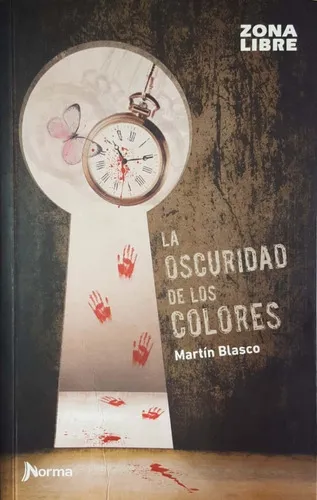Hoy les traigo una reseña del libro “La oscuridad de los colores”, el cual leí hace un par de años en la escuela. Decidí hacer esta reseña porque creo que este libro, al igual que otros, están infravalorados y que deberían darse a conocer más entre los jóvenes. Es un libro perfecto para adolescentes y para analizar en el ámbito escolar.
Today I bring you a review of the book "The Darkness of Colors", which I read a couple of years ago at school. I decided to do this review because I think this book, like others, are underrated and should be more widely known among young people. It is a perfect book for teenagers and to discuss in a school setting.

La portada de la primera edición presenta tonos oscuros y figura el ojo de una cerradura con marcas de manos ensangrentadas, un reloj de bolsillo y una mariposa. Podemos decir con certeza que transmite sensaciones de misterio e inquietud.
The cover of the first edition has dark tones and features a keyhole with bloody hand marks, a pocket watch and a butterfly. We can say with certainty that it conveys feelings of mystery and uneasiness.
La novela se ambienta en Buenos Aires, en el año 1910 (fecha del centenario de la patria) y narra la historia de cómo Alejandro, un periodista hijo de inmigrantes judíos quien es contratado por el padre de una mujer reaparecida (la cual no recuerda nada de lo sucedido), descubre la oscura verdad tras la desaparición de 5 bebés, los cuales habían sido raptados 25 años atrás. Pero es cuando reaparece uno de los desaparecidos teniendo comportamientos inhumanos y sin la capacidad de hablar que las cosas empiezan a tomar un giro turbio y misterioso.
The novel is set in Buenos Aires, in the year 1910 (date of the centenary of the homeland) and tells the story about how Alejandro, a journalist, son of Jewish immigrants who is hired by the father of a reappeared woman (who does not remember anything of what happened), discovers the dark truth behind the disappearance of 5 babies, which had been kidnapped 25 years before. But it is when one of the missing reappears having inhuman behaviors and without the ability to speak that things begin to take a murky and mysterious turn.
La novela está estructurada en dos partes, que se intercalan entre sí: una se corresponde a la trama en la que Alejandro es protagonista. Está narrada en tercera persona, desde un punto de vista focalizado en Alejandro, que sigue sus pasos y descubrimientos en el caso y que ofrece una mirada sobre sus pensamientos y reflexiones. La otra parte está conformada por fragmentos del diario íntimo de un tal J. F. Andrew, datados 25 años atrás, que, a medida que la historia de Alejandro se despliega, explican lo sucedido con los cinco niños raptados en 1885 y el rol del propio Andrew y de sus ayudantes en todo esto.
The novel is structured in two parts, which are interspersed with each other: one corresponds to the plot in which Alejandro is the protagonist. It is narrated in the third person, from a point of view focused on Alejandro, who follows his steps and discoveries in the case and offers a glimpse into his thoughts and reflections. The other part is made up of fragments of the intimate diary of one J. F. Andrew, dated 25 years ago, which, as Alexander's story unfolds, explain what happened to the five children abducted in 1885 and the role of Andrew himself and his assistants in all this.
En conclusión, es un libro que merece ser leído. Es relativamente corto y fácil de leer para aquellos que se están adentrando en el mundo de la lectura.
In conclusion, it is a book that deserves to be read. It is relatively short and easy to read for those who are just getting into the world of reading.
